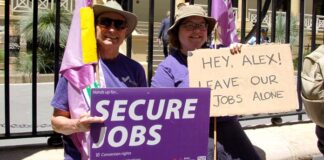On Tuesday May 19, 30,000 Queensland teachers held a 24-hour strike over the measly 12.5 per cent pay rise over three years offered by the Queensland Government. The Queensland Teachers Union (QTU) convened 49 meetings across the state, the largest in Brisbane with over 4000 workers.
The lively meeting was brimming with confidence—support for the strike was overwhelming and over 1000 teachers joined the union in the week before the strike. The meeting voted unanimously for “further strike action, work bans, non-cooperation with new department initiatives, as well as public protests.”
In the days leading up to the strike, Education Minister Geoff Wilson had been guaranteeing schools would be open, urging parents to send their children to school. But confronted with the massive support for the strike, the day before, the government asked parents to keep their children home.
Even with the pay deal offered by the Bligh Government, Queensland teachers would still be some of the lowest paid in the country, with beginning salaries almost $4000 less than teachers in NSW and WA.
While pay was the issue at the forefront of the strike, many other issues are making teachers angry.
It is becoming increasingly clear that state and federal governments are going to use the national curriculum and National Assessment Program—Literacy and Numeracy (NAPLAN) to increase teacher workloads, publish school league tables and push performance pay.
The working conditions of contract teachers were also raised at the mass meeting. Contract teachers do not get paid for school holidays and a fourth year teacher told the meeting that she is currently on her sixteenth contract. There are also ongoing problems with class sizes and retention, with currently only 45 per cent of graduates still teaching by the time they are 35. The union also wants lesson observation, release time and inductions for new teachers to increase retention.
The teachers’ dispute is looming as the first real test of unions in Queensland since the economic crisis hit. On the day of the strike Bligh announced a $5.6 billion drop in expected GST revenue over the next four years and says the government is considering cutting public servants’ wages and selling-off assets like Energex and Queensland Rail to cover their budget black hole.
Bligh has got a fight on her hands. A win for the teachers will boost the confidence of other government workers to say no to pay cuts and privatisation.
By Rob Nicholas





